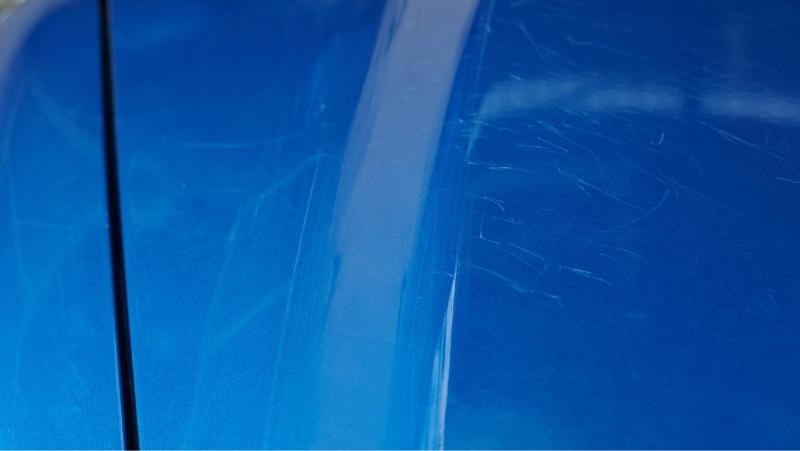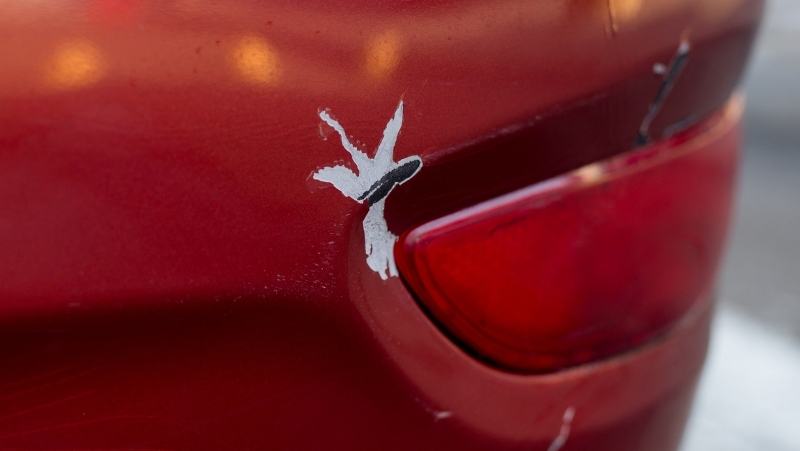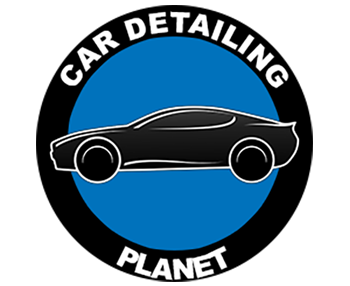3 Types of Car Scratches and Ways To Fix Them (With Images)
Car Detailing Planet is a part of Amazon Associates. As an Amazon Associate, we earn from qualifying purchases. Read our Affiliate Disclosure to learn more.

If you want to fix some car scratches, you should first know how to identify them in order to pick the right approach for removing them from the car’s paint. In this post, I’ll show you three main types of car scratches, how to identify them, and most importantly, ways of fixing them.
The 3 main types of car scratches are:
- Clear coat scratches are tiny and shallow scratches that have only superficially damaged the clear coat on your vehicle.
- Base coat (paint) scratches are medium-deep scratches that go through the clear coat and damage your vehicle’s paint.
- Primer coat scratches are the deepest scratches on the paintwork that go all the way to metal or plastic.
Clear Coat Scratches

The clear coat is the last layer of car paint. It’s a transparent layer protecting your car from UV rays, heat, oxidation, and other external factors. Also, a clear coat gives your car’s paint shine and gloss.
Clear coat scratches are the most common type of car scratches. Literally, every car has them, and it’s impossible to avoid them completely.
Not all cars have a clear coat, but all vehicles made in the last 20-30 years should have a clear coat applied.
Common causes of clear coat scratches:
- improper washing techniques (swirl marks)
- road grime
- lightest accidents with cars
- trees and grass on the road
- touching paint with hands
- keeping some stuff on the cars’ surface (soaps, drinks, etc.)
How To Repair Clear Coat Scratches
Clear-coat scratches appear very easily on the car’s paint but are also the easiest ones to repair.
When fixing clear coat scratches, detailers have to remove a bit of clear coat around the scratch and smoothen the whole area. That way, a clear coat scratch will disappear.
To fix clear coat scratches, you have three options:
- Hand polish the vehicle: it’ll do the job, but it requires a lot of elbow grease. Trust me; you don’t want to hand-polish the whole car. I suggest you hand polish if you’re going to remove a few scratches without spending additional money buying a machine polisher.
- Machine polish the vehicle: with DA or rotary machine polisher, removing light to medium clear coat scratches is a piece of cake. With just a little knowledge, you can get your car’s paint to perfection.
- Wet sanding with sandpaper (2000 or more): some deeper clear coat scratches won’t easily go away with compounding or polishing. They are removed with very fine sandpapers with a grade of 2000 or 3000. After that, you should again compound and then polish it to perfection.
Base Coat (Paint) Scratches

The base coat is the thinnest layer of paint that gives color to your vehicle. It can be black, white, red, or any other color, even pearl. The base coat is just under the clear coat layer.
Base coat or paint scratches are the second most common type of scratches. Paint scratch is every scratch that went through the clear coat and damaged the paint layer of the vehicle.
Common causes of base coat scratches:
- Car accidents
- Hitting the wall with car doors
- Road rocks
- Someone doing it with a purpose (scratching your car with a key, etc.)
How To Repair Base Coat Scratches
Since base coat scratches damaged your vehicle’s paint, your car will often need a repaint job.
That usually includes:
- wet sanding
- spraying paint (base) coat
- spraying clear coat
- polishing
However, if there are only minor scratches from rock chips, door hits, or key scratches, you can fix them with a little bit of wet sanding, compounding, and polishing. By doing that, you won’t fix the scratch, but you’ll evenly level out the paint around it so the scratch isn’t visible.
And again, don’t forget to apply some paint protection after fixing it.
If you don’t have any experience, I suggest you take your car to a professional. That way, you’ll avoid doing any additional damage to the car’s paint.
Primer Scratches

Primer is a layer of coat that protects the car’s body (metal or plastic) from rusting and is also used to smoothen the surface so the paint coat and clear coat can be applied.
Primer scratches (often called deep paint scratches) are the deepest scratches that go all the way through the clear coat and base coat and damage the primer. Often, you’ll see metal or plastic beneath.
If you see a metal or plastic of the car body, that’s a 100% primer scratch.
Common causes of primer coat scratches:
- Car accidents
- Hitting the wall or other car with a car door
- Scratching the vehicle with some harsh metal
How To Repair Primer Scratches
If you want to fix primer coat scratches on your vehicle, I suggest visiting a professional.
Usually, the whole car panel (hood, bumper, etc.) will be repainted to get the best possible result. If you’re a DIY, you can fix it by yourself, too, but it won’t look nearly as good as if you go to a professional.
Fixing primer coat scratches usually goes like this:
- dry sanding and wet sanding the whole car body panel
- applying body filler if needed
- wet sanding again
- applying primer coat
- wet sanding
- spraying paint coat
- spraying clear coat
As you can see, it’s a pretty lengthy procedure that requires a lot of experience and knowledge. And it costs a lot of money too.
However, if there are only minor scratches on your vehicle and you want to try fixing it yourself, I suggest that you check out the video below.
How To Identify Different Types Of Scratches
I made images that explain each type of vehicle scratch, so make sure to check them out below.

Clear Coat Scratch Explained

Base Coat Scratch Explained

Primer Scratch Explained
Here’s a quick guide for you to identify what type of car scratch your car has:
- Clear Coat Scratches: run your fingernail over the scratch. If you can barely feel the scratch, it’s a clear coat scratch and can be easily fixed by polishing your vehicle.
- Base Coat Scratches: when you run your fingernail over the scratch and feel the scratch a lot, it probably went through the clear coat to the paint coat.
- Primer Coat Scratch: if you can see the metal or the plastic of the car body, and there’s no paint, that’s a primer coat scratch.
In the end, I want to show you how professionals divide car paint scratches. Professionals divide scratches into five different levels. Level 1A is the least severe, while level 4 is the most severe car scratch. Check the table below.
| Level of scratch | Severity |
|---|---|
| 1A | X |
| 1B | XX |
| 2 | XXX |
| 3 | XXXX |
| 4 | XXXXX |
Preventing Car Scratches
Preventing car scratches is just as important as knowing how to fix them. By taking preventive measures, you can maintain the aesthetic appeal of your car and preserve its resale value. Here are some effective ways to prevent car scratches, ranked from the most to least effective:
Paint Protection Film (PPF)
PPF is the most effective way to prevent car scratches. It’s a thin layer of film that is applied over your car’s paint. This film acts as a barrier, protecting your car from scratches, chips, and other minor damages.
Benefits of PPF
- Scratch Resistance: PPF is highly resistant to scratches. Even if it gets scratched, the film is self-healing, meaning it can repair itself when exposed to heat.
- Durability: PPF is highly durable and can last for several years, offering long-term protection for your car.
- Invisible Protection: PPF is clear, so it doesn’t alter the appearance of your car. It provides protection while maintaining the original look of your car’s paint.
Ceramic Coating
Ceramic coating is the second-best option for preventing car scratches. It’s a liquid polymer that bonds with your car’s paint and forms a protective layer.
Benefits of Ceramic Coating
- Scratch Resistance: While not as effective as PPF, the ceramic coating does offer some level of scratch resistance.
- Long-lasting: Ceramic coatings can last for several years, providing long-term protection.
- Enhanced Gloss: In addition to protection, ceramic coatings enhance the gloss of your car’s paint, giving it a shiny and new appearance.
Sealants
Car sealants are the third-best option for preventing car scratches. They are synthetic products that provide a protective layer over your car’s paint.
Benefits of Sealants
- Protection: Sealants offer protection against minor scratches (swirl marks) and other damages. But it’s almost nothing when compared to ceramic coatings and PPF.
- Longevity: Car sealants can last for several months, offering more protection than regular car waxes.
- Easy to Apply: Sealants are generally easy to apply and can be done at home.
Waxes
Car waxes are the least effective option for preventing car scratches. However, they still offer some level of protection and are better than not using any protection at all.
Benefits of Waxes
- Minor Protection: Waxes can barely protect against any scratches and damages.
- Enhanced Shine: Waxes can enhance the shine of your car’s paint, giving it a glossy finish.
- Affordable: Car waxes are generally more affordable than the other options.
Here’s a table summarizing the effectiveness of each method:
| Method | Scratch Resistance | Durability | Additional Benefits |
|---|---|---|---|
| PPF | High | Several years | Invisible protection |
| Ceramic Coating | Medium | Several years | Enhanced gloss |
| Sealants | Low | Several months | Easy to apply |
| Waxes | Very Low | Few weeks | Affordable, enhanced shine |
Remember, the best way to prevent car scratches is to combine these methods with careful handling of your car. Avoid parking in risky areas, use car covers when necessary, and keep your car clean to minimize the risk of scratches.
FAQs
Minor scratches can often be completely removed, while deeper scratches can be significantly reduced.
The cost varies depending on the severity of the scratch and the repair method, ranging from affordable DIY kits to more expensive professional services.
Scratch repair kits can be effective for minor scratches but may not work as well for deeper ones.
It depends on your policy. Comprehensive coverage may cover significant scratch repair, but it’s best to check with your provider.
Bottom Line
Car scratches are an unfortunate but common part of car ownership. Understanding the different types of scratches and how to repair them can help maintain your car’s appearance and value.
While prevention is the best approach, it’s also important to know how to address scratches when they do occur.
